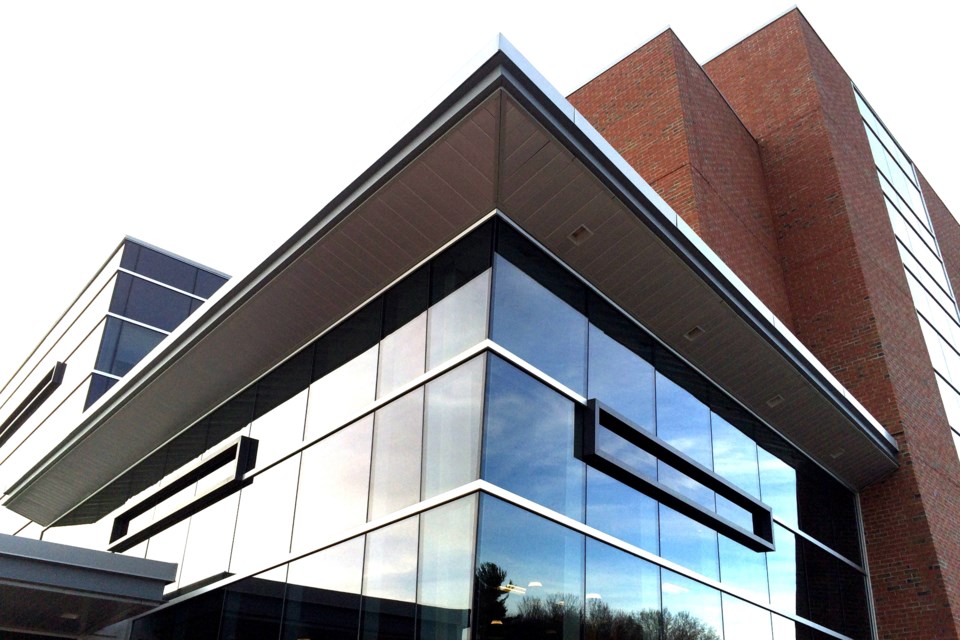Algoma University's five-year-old biosciences and technology convergence centre could become a lot bigger, with help from a $2 billion federal investment in post-secondary institutions.
An $18 million, four-storey addition to the steel-and-glass centre was one of three projects that received approval in principle last night from the university's board of governors.
Also approved in principle were a new three-storey centre for Anishinaabe and professional studies costing $20 to $25 million, and a $6 million energy upgrade for Shingwauk Hall, the university's 81-year-old main building housing classrooms and administrative and faculty offices.
No one realistically expects all three projects to be approved under the $2 billion Post-Secondary Institutions Strategic Investment Fund announced on April 6 by Justin Trudeau's Liberal government.
Even if Algoma University scores major building dollars under the federal infrastructure program, the Algoma U board so far has no plan for procuring the millions of dollars in matched funding needed to complete the projects.
"We definitely want to try to take advantage of the infrastructure spending that is about to take place," said President Craig Chamberlin.
The science building expansion and new Anishinaabe and professional studies building have previously been submitted to the Ontario government's infrastructure program, Chamberlin said.
The Shingwauk Hall energy upgrade was developed specifically for the federal program.
Science and technology building
The $21.5 million biosciences and technology convergence centre was built in 2009 using federal stimulus funding.
It was designed to accommodate expansion.
Housed within its 77,363 energy-efficient square feet are the Sault Ste. Marie Innovation Centre and Algoma Games for Health, research institutes for health informatics and invasive species, as well as classrooms and meeting rooms.
The proposed four-storey addition to the building would add 35,000 square feet of new research laboratories, technical space, offices, dedicated study space and rooms for flexible learning and instruction.
"This academic building will fill a significant need for increased learning and student spaces on campus," said Sean Dwyer, the university's vice president finance and administration, in a report presented to governors last night.
The expansion would also have an energy-efficient design including daylight-harvesting LED lighting systems and high-efficiency heating and cooling systems.
Centre for Anishinaabe and Professional Studies
The proposed centre for Anishinaabe and professional studies would be a new three-story, 40,000-square-foot building with steel frame and concrete deck.
Here's how Dwyer describes it:
"The location for this new building will take into account the historical significance of the site and the connection to Anishinaabe culture. Its use of local materials like cedar and pine, and the extensive use of a glass curtain wall, will allow views of the traditional waterways of the St. Mary's River and the surrounding lands, showcasing the heritage of the lands and peoples and pointing towards the future of professional studies programs much sought after by students at the university."
"The building will include a traditional roundhouse with nine sides that embodies clans, families and community. The centre will focus on multi-use learning spaces, which will be flexible to accommodate a wide range of knowledge sharing and teaching methods, as well as offices, dedicated study spaces and meeting rooms."
Shingwauk Hall energy upgrade
The $5 million energy upgrade proposed for Shingwauk Hall would replace the current heating and cooling system with high-efficiency boilers, a cooling tower, air handling units, pumps and a secondary cooling loop with free cooling.
All lighting would be upgraded to LED fixtures with daylight harvesting.
The project proposal also calls for replacement of all windows as well as roof repairs.
High-efficiency plumbing fixtures would be installed in washrooms, which would be upgraded to allow barrier-free accessibility through the entire building.
Removal of all known hazardous materials is also planned.
Tight deadline
Across Canada, colleges and universities are scrambling to meet the tight deadline for applying for the new infrastructure cash.
Details of the federal program were just announced on April 6, but applications must be submitted by May 6, with approval in principle from institutional boards.
The Ontario government's deadline for infrastructure funding is even tighter.
The province announced earlier this week that applications must be submitted by today, Dwyer told last night's meeting.
Last night's approval in principle is far from being the final go-ahead on the building projects, President Chamberlin said.
"We're looking for the opportunity to try to move forward with these projects. Yes, there's lots more work to be done. What we're looking for is the opportunity to at least try to explore and find the matched funding."
President Chamberlin said that the federal government will provide 50 percent of the cost of the accepted projects.
"It's up to the university to provide the other 50 percent of the funding," Chamberlin said.
It's possible that provincial infrastructure money may be used as matching dollars on federally funded projects, he added.
"It is considered unlikely that more than one project will be approved," Dwyer advised governors last night.
"In the event that one or more projects are approved, they will be brought through the finance committee and the board for deeper analysis and review," Dwyer said.
It's not known when successful applications to the federal program will be notified.
